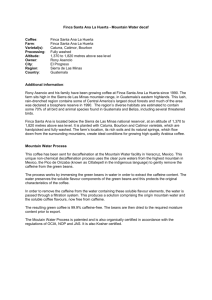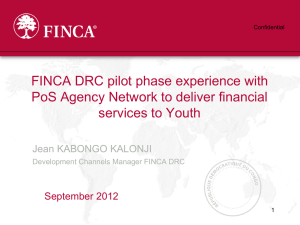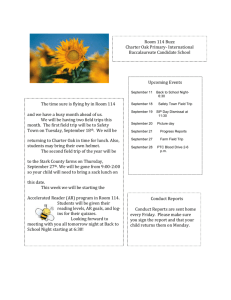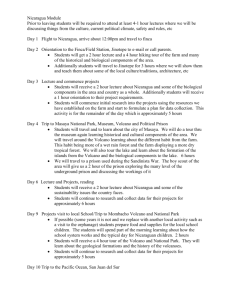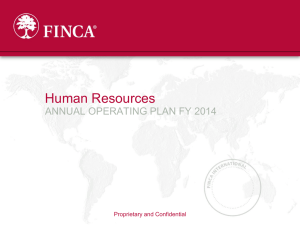Chiapas_Tour
advertisement
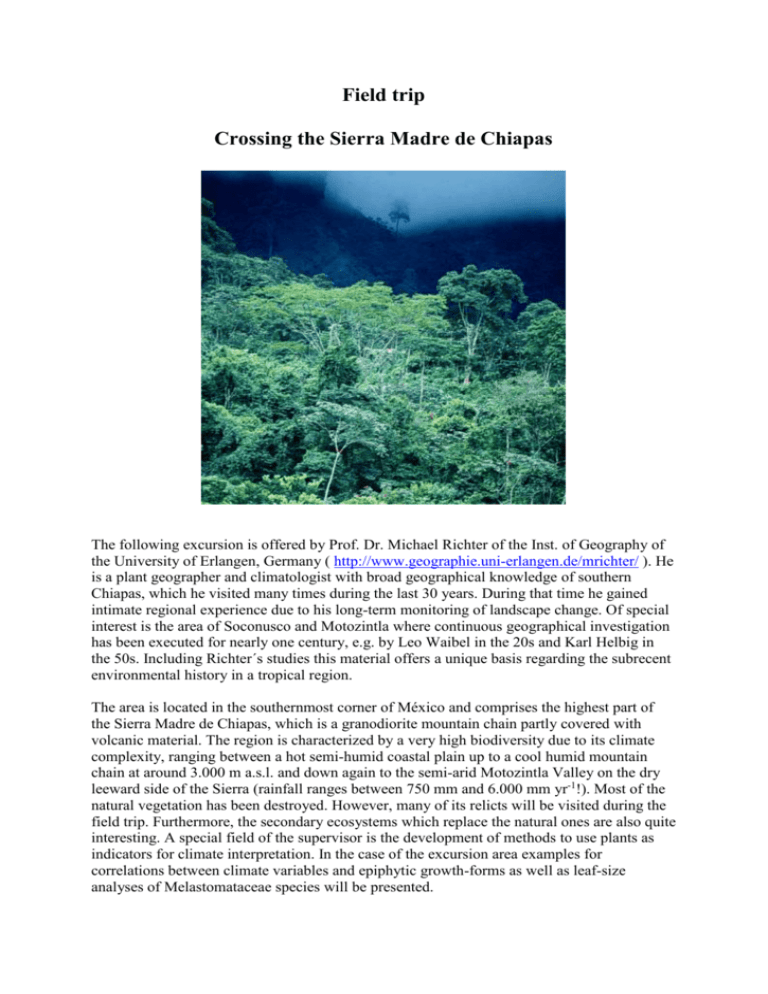
Field trip Crossing the Sierra Madre de Chiapas The following excursion is offered by Prof. Dr. Michael Richter of the Inst. of Geography of the University of Erlangen, Germany ( http://www.geographie.uni-erlangen.de/mrichter/ ). He is a plant geographer and climatologist with broad geographical knowledge of southern Chiapas, which he visited many times during the last 30 years. During that time he gained intimate regional experience due to his long-term monitoring of landscape change. Of special interest is the area of Soconusco and Motozintla where continuous geographical investigation has been executed for nearly one century, e.g. by Leo Waibel in the 20s and Karl Helbig in the 50s. Including Richter´s studies this material offers a unique basis regarding the subrecent environmental history in a tropical region. The area is located in the southernmost corner of México and comprises the highest part of the Sierra Madre de Chiapas, which is a granodiorite mountain chain partly covered with volcanic material. The region is characterized by a very high biodiversity due to its climate complexity, ranging between a hot semi-humid coastal plain up to a cool humid mountain chain at around 3.000 m a.s.l. and down again to the semi-arid Motozintla Valley on the dry leeward side of the Sierra (rainfall ranges between 750 mm and 6.000 mm yr-1!). Most of the natural vegetation has been destroyed. However, many of its relicts will be visited during the field trip. Furthermore, the secondary ecosystems which replace the natural ones are also quite interesting. A special field of the supervisor is the development of methods to use plants as indicators for climate interpretation. In the case of the excursion area examples for correlations between climate variables and epiphytic growth-forms as well as leaf-size analyses of Melastomataceae species will be presented. Next to biological aspects some of agricultural, social and cultural interest will be addressed too. Possibilities of sustainable management for different land use methods are discussed within the various economic formations ranging from the cash-crop orientated coastal lowland (up to 150 m a.s.l.) with mostly mestizo population, to the almost monocultural coffee zone (500-1600 m a.s.l.) with white plantation owners, and to the Indian milpa zone (“corn and beans”) near the crest area of the Sierra (2.000-2.800 m a.s.l.). Ecological problems of these various economic belts will be highlighted including their effects on the neighbouring zones. There will be opportunities to discuss social and cultural aspects based on observations and experiences of a “neutral non-native expert”. Places of special interest round off the program. Several visits are planned, e.g. at a large bird aviary on famous Finca Irlanda, at an ornamental plant cultivation as an alternative possibility for crop-diversification on Finca Argovia and at the most important supraregional ecological center ECOSUR in Tapachula. The trip will take six days including the morning flight to and an evening flight back from Tapachula to México DF. Apart from transfers by bus and truck (!) some strenuous hikes are to be expected (up to 15 kms including 1.500 m way down per day). You should also expect strong downpours, since the rainy season might just be at its peak. Rubber boots or hiking boots and raingear as well as an ample daypack are indispensable. Note: This is no at all an ordinary and conventional but a physically challenging trip ! As Michael Richter lives in Germany, at the moment he can´t give an exact price amount. However, the whole trip will probably not exceed 700.- US$ (including tranfers by air and bus and accommodation). An exact calculation will follow at the end of May. "The trip will start at the airport of Mexico DF in the morning of July 20 and the return flight from Tapachula will be at July 25 (afternoon or evening = as requested). The registration of this excursion must be executed up to June 25 since the flights must be booked then ! Otherwise we have to cancel the excursion... " Form of payment: To register and pay for the trip press HERE . Any cancellation will have a penalty of 5% for bank fees. In case of having less than 12 registrants before June 25, the trip will be cancelled and money reimbursed to registrants at Morelia, taking 5 % for bank fees. Cancellations after June 25 will have a total deduction of $ 400 USD as by this time airplane and bus reservations can not be cancelled and money can not be paid back. Registration and payment are not possible at Morelia. Any questions regarding the trip, please contact the organizer Michael Richter at sairecabur@web.de, http://www.geographie.uni-erlangen.de/mrichter/ or Horacio Paz at hpaz@oikos.unam.mx Number of participants: Minimum of 12 and maximum of 20. The trip will be cancelled if less than 12 participants sign up. Schedule is as follows: 1. day: flight DF-Tapachula; topics; ecological problems caused by cash crops in the coastal plain, visit of mangroves near Mazatlan, overnight probably at Tapachula 2. day: bus trip from Tapachula to Motozintla; topics: climatology, geomorphology and erosion by overgrazing, hazards caused by flooding, e.g. hurricane “Stan”, overnight at Motozintla 3. day (starting with a “easy” hike): surroundings of the dry valley of Motozintla; topics: epiphytism, dry oak and pine forests, spontaneous vegetation in Indian milpa fields, reasons for indigenous religion conflicts (hike of some five hours), night at Motozintla 4. day (this is really a hard one!): pick up transfer from Motozintla to Niquivil (3.000 m); topics: mountain coniferous forests, smuggling and illegal immigration from Guatemala. Further transfer down to Pinabeto (2.400 m), from there hike of 15 kms down to Finca Argovia (700 m); topics: milpa versus mountain rainforests, deforestation, epiphytism and climatic phytoindication, overnight at Finca Argovia 5. day (a nice one for regeneration…): Finca Argovia and Finca Irlanda (by truck); topics: bird in Finca Irlanda, spontaneous vegetation on coffee plantations, comparison of bioecological and chemo-technical treatment, floriculture, overnight Finca Argovia 6. day: return to Tapachula, visit of ECOSUR, return flight to México DF View from Finca Argovia towards Volcán Tacaná (4.064 m) and Tajumulco (4.200 m) Spanish version of the schedule / versión en español: Primer dia: vuelo desde DF a Tapachula, visitar un manglar en la costa Pacífica cerca de Mazatán, noche en Tapachula. Segundo dia: viaje desde Tapachula a Motozintla (temas: climatología, geomorfología y erosión causada por sobrepastoreo, daños causados por inundaciones, p.e. huracan "Stan"), noche en Motozintla Tercer dia: alrededores del valle seco de Motozintla (temas: epifitismo, encinales y pinales secos, vegetación espontanea de la milpa indigena, causas de conflictos entre las religiones; caminata de unas cuatro horas), noche en Motozintla Dia cuatro: viaje con camionetas desde Motozintla por Niquivil (3000 m) (tema: bosque de montaña, contrabando y paso de frontera desde Guatemala por migrantes ilegales) y además por Pinabeto (2400 m); desde allí caminata de unas 15 kilómetros por Finca Argovia en la zona cafetalera (caminata dura! Temas: climatologia y pisos de vegetación, destrucción de los bosques de montaña, epifitismo y fito-indicación climatica), noche en Finca Argovia. Dia cinco: Finca Argovia y Finca Irlanda (temas: aves en la Finca Irlanda, vegetación espontanea de los cafetales, comparación de cafetales con tratamiento bio-ecologico y chimo-tecnico, floricultura como ejemplo de diversificación de cultivos), noche en Finca Argovia Dia seis: Regreso por Tapachula, vuelo por DF.

